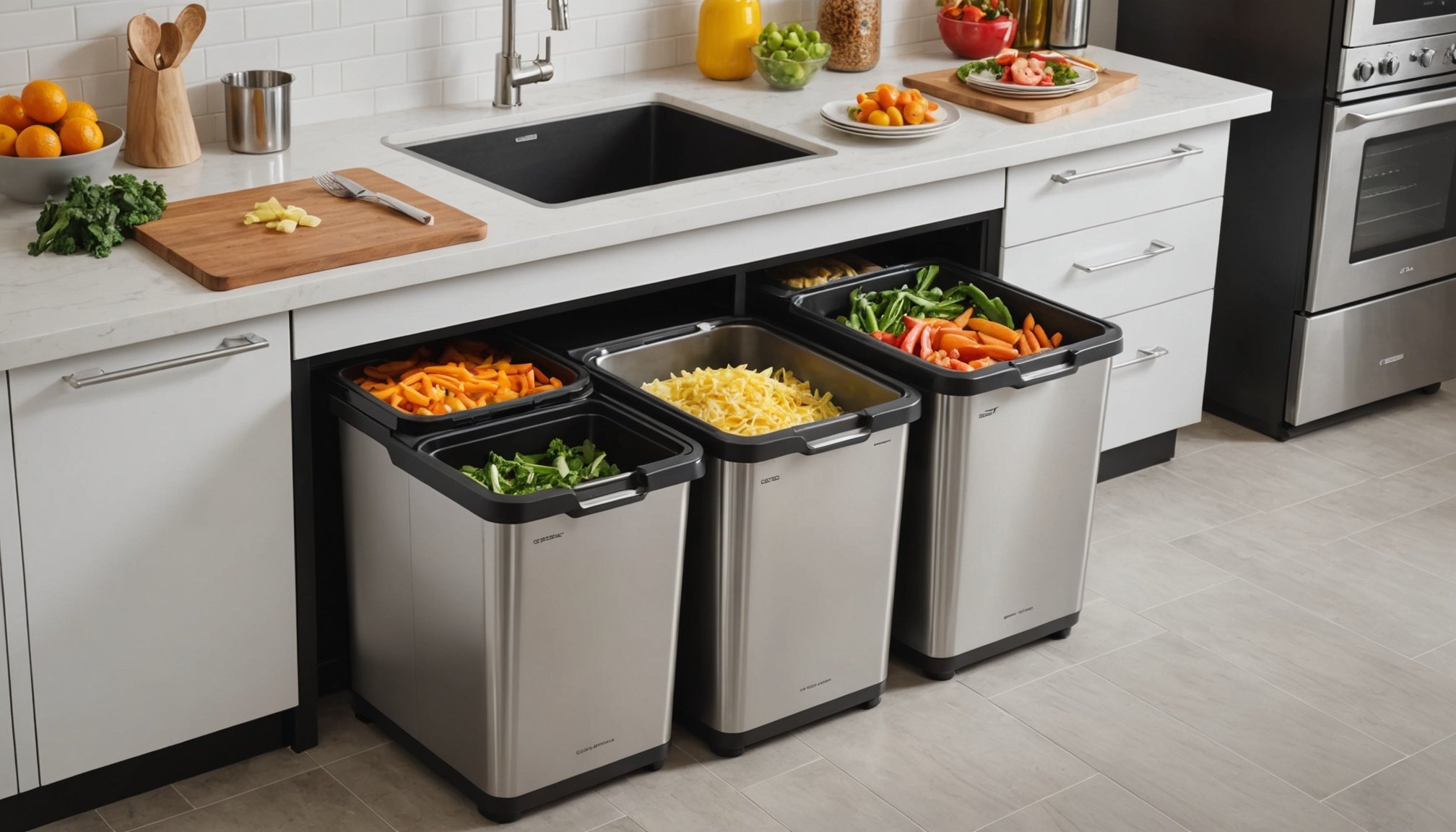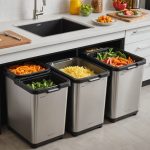Importance of a Smart Waste Sorting System
Implementing a smart waste management system plays a pivotal role in reducing food waste and revamping culinary spaces. These systems efficiently separate organic waste from recyclables, leading to less food wastage and a more sustainable kitchen. With proper healthier kitchen practices, individuals are more likely to minimize leftovers and spoilage, thus lessening their environmental impact.
Environmental Impact and Kitchen Sustainability
A smart waste sorting system contributes significantly to environmental conservation. By efficiently separating waste, it supports recycling and composting efforts, consequently reducing landfill dependence. This proactive approach not only benefits the environment but also ensures kitchens operate more sustainably by embracing eco-friendly practices.
Also to read : Boost your meal prep: how kitchen island positioning enhances healthy cooking efficiency
Promoting Healthier Eating Habits
Utilizing an efficient waste sorting system can lead to healthier eating habits. By becoming more aware of the type and amount of waste generated, individuals are encouraged to plan meals more carefully, prioritize fresh ingredients, and avoid over-purchasing. Consequently, this supports a healthier lifestyle while minimizing waste in the kitchen.
In conclusion, the introduction of smart waste systems can greatly enhance culinary spaces while fostering environmentally conscious and healthier kitchen practices. Their dual role in reducing waste and promoting sustainability makes them essential for both individual households and broader community efforts to combat food wastage.
Features of Effective Smart Waste Sorting Systems
In the rapidly evolving realm of kitchen technology, smart waste sorting systems stand out. These advanced solutions streamline food waste management, providing both ecological benefits and user-friendly features.
Key Components of Smart Waste Sorting Systems
Effective systems consist of essential components that enhance functionality. These include sensors to identify food waste and sort it accordingly, and smart bins equipped with technology to facilitate efficient waste separation. The ability to handle diverse waste types seamlessly is key to their success, ensuring easy and effective categorisation.
How Technology Enhances Food Waste Management
Technology plays a pivotal role, boosting the efficiency of waste management. Smart systems often utilise AI and machine learning algorithms to improve sorting precision and optimise waste categorisation. These innovations allow for better resource allocation and reduced environmental impact, underscoring their importance in contemporary kitchen ecosystems.
User-Friendly Designs and Integration
User-friendliness is paramount for widespread adoption. Smart waste sorting systems often feature intuitive interfaces and seamless integration with existing kitchen setups. This ease of use encourages consistent use, promoting more sustainable waste practices. Whether in a home or commercial setting, these systems can adapt to user needs through personalised settings and streamlined operation, making them a worthwhile investment for those committed to reducing their environmental footprint.
Benefits of Upgrading Your Kitchen with a Smart Waste Sorting System
A smart waste sorting system can revolutionise your kitchen in various ways, promoting healthier eating benefits and enhancing kitchen efficiency. By integrating such a system, you encourage more mindful cooking and eating habits. This sophisticated technology can help track food waste, providing insights into what and how much you are discarding. Consequently, it encourages you to make deliberate choices about meal planning and consumption.
Moreover, a smart waste sorting system aids in the reduction of spoilage, facilitating better inventory management. With its ability to notify you about approaching expiration dates, it reduces waste significantly. This systematic approach keeps your kitchen organised and streamlines your culinary improvements by allowing you to focus on cooking fresh and nutritious meals.
The impact on meal planning and grocery shopping habits is another notable aspect. With better insight into waste patterns, you can adjust your buying habits, purchase only what is necessary, and plan meals more effectively. This conscious approach not only saves money but also contributes to a more sustainable lifestyle.
Embracing smart waste sorting ultimately transforms how you interact with your kitchen, making it a hub of efficiency and sustainability.
Practical Tips for Implementing a Smart Waste Sorting System
Introducing a smart waste sorting system involves a thoughtful approach to kitchen revamping. This ensures not only an efficient setup but also seamless integration with your existing kitchen layout.
Step-by-step guide to setting up a smart waste sorting system
Begin by selecting a waste sorting system that suits your kitchen’s needs. Installation guides usually suggest choosing an accessible location, possibly under the sink or in a dedicated pantry space. Ensure the designated area has sufficient room for the various components of the system.
As you install, follow each step attentively to optimise functionality. Start by securing the base unit and adjusting compartments to accommodate different types of waste. Refer to the instructions specific to your product for maximum efficiency.
Tips for integrating with existing kitchen layouts
When integrating the system into your existing kitchen, consider the flow of movement. Waste sorting should become a natural part of your kitchen routine. Align the waste sorting bins with your prep and cooking areas.
Best practices for maintaining the system and ensuring effectiveness
Regular maintenance is crucial. Empty bins frequently to prevent overflow and unpleasant odours. Clean the compartments to avoid contamination between waste types. This upkeep not only preserves the system’s longevity but also enhances its efficiency.
Consider these tips as you revolutionise your kitchen into an efficient waste-sorting hub.
Recommended Smart Waste Sorting Products
In the era of sustainability, smart waste sorting systems are transforming how we handle household waste. With an array of innovative technologies, these systems streamline recycling and waste management, providing both convenience and environmental benefits.
When considering product recommendations, seek out waste sorting systems that offer a balance of quality and functionality. Some popular options on the market include the Simplehuman Sensor Can with a voice and motion sensor, Lomi by Pela, which converts waste into compost at home, and the Joseph Joseph TotemMax, known for its modular design and multiple compartments.
A crucial factor in selecting smart kitchen gadgets for waste management is understanding the features. Advanced models boast sensor technologies for automatic lid opening, built-in composting capabilities, and integrated recycling guides. Prices differ significantly, with basic models starting from around £50, while more advanced systems may reach up to £300 or more.
User experiences reveal insights into the practicality and durability of these products. Most users appreciate the convenience of hands-free operation and the reduction in household waste. To find these waste sorting systems, major online retailers like Amazon and specialised home goods stores provide a range of choices. It’s wise to consider installation requirements and kitchen space suitability when choosing the perfect waste sorting solution for your home.
Visual Examples and Testimonials
Transforming your kitchen can be a game-changer, and numerous user experiences highlight how impactful a kitchen revamp can be. Through success stories, we see how these changes not only enhance aesthetics but also improve daily living.
Before-and-after Kitchen Revamp Examples
Before-and-after images can be powerful motivators. Imagine a cluttered, inefficient kitchen turning into a modern, streamlined haven. These revamps aren’t just about looks; they significantly influence how people use their space, inspiring creativity and efficiency in the kitchen.
User Testimonials About Enhanced Eating Habits
There are countless testimonials where users report improved eating habits post-revamp. By redesigning their kitchens, individuals find themselves encouraged to prepare healthier meals, leading to long-term benefits both physically and mentally. Better organisation and access to fresh ingredients often stimulate more frequent cooking at home.
Case Studies of Waste Reduction and Culinary Improvements
Studies show a significant reduction in waste following kitchen makeovers. With better storage solutions and a focus on sustainability, users report throwing away less food. Furthermore, culinary improvements blossom when appliances and tools are optimally placed, allowing cooks to maximise their culinary skills. These kitchen transformations prove to be both environmentally friendly and empowering.











